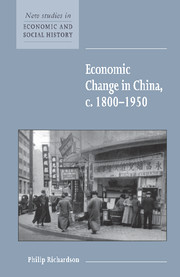Book contents
- Frontmatter
- Contents
- List of maps
- Acknowledgements
- Note on references
- Guide to pronunciation
- Dynastic chronology
- Weights and measures
- Map 1: China: provinces and cities
- Introduction
- 1 Analytical frameworks
- 2 The eighteenth-century legacy and the early nineteenth-century crisis
- 3 Growth and structural change
- 4 Foreign trade and investment
- 5 Industry: traditional and modern
- 6 Agriculture
- 7 The state and the economy
- 8 Conclusion: the legacy of the past
- Bibliography
- Index
- New Studies in Economic and Social History
- Previously published as Studies in Economic and Social History
- Economic History Society
6 - Agriculture
Published online by Cambridge University Press: 05 June 2012
- Frontmatter
- Contents
- List of maps
- Acknowledgements
- Note on references
- Guide to pronunciation
- Dynastic chronology
- Weights and measures
- Map 1: China: provinces and cities
- Introduction
- 1 Analytical frameworks
- 2 The eighteenth-century legacy and the early nineteenth-century crisis
- 3 Growth and structural change
- 4 Foreign trade and investment
- 5 Industry: traditional and modern
- 6 Agriculture
- 7 The state and the economy
- 8 Conclusion: the legacy of the past
- Bibliography
- Index
- New Studies in Economic and Social History
- Previously published as Studies in Economic and Social History
- Economic History Society
Summary
The symbiosis between constancy and change which underlies the Chinese experience as a whole is nowhere more apparent than in the agricultural sector. Over the two centuries down to 1949, the absence of fundamental change in farming technology and organisation, in the structure of ownership or in the traditional institutions and belief systems imparted a strong element of continuity to the form and rhythm of rural life. The ever-present vulnerability to the vagaries of the climate and the persistent threat of natural or man-made disaster simply served to reinforce the utopian attractiveness of certainty and stability achieved through tried and tested means. At the same time a momentum for change was being generated by a rise in population which outstripped the extension of cultivated area, by the intensified commercialisation which became evident in the second half of the period and by the general breakdown in state–peasant relations which culminated in the intrusion of revolutionary ideals and practices. Progressively, stability could no longer be achieved without change.
From a long-term perspective (i.e. twelfth century onwards) output continued to rise in line with population. Prior to the eighteenth century, output growth resulted from a combination of the extension of cultivated land and productivity gains (Perkins assigns 55 per cent and 45 per cent respectively) [82: 26]. By the early nineteenth century, very little further increase of the cultivated area was possible except in Manchuria and the northwest and the burden of feeding the rising population at existing levels of sustenance fell, almost entirely, on the ability to achieve a commensurate increase in productivity.
- Type
- Chapter
- Information
- Economic Change in China, c.1800–1950 , pp. 68 - 83Publisher: Cambridge University PressPrint publication year: 1999

